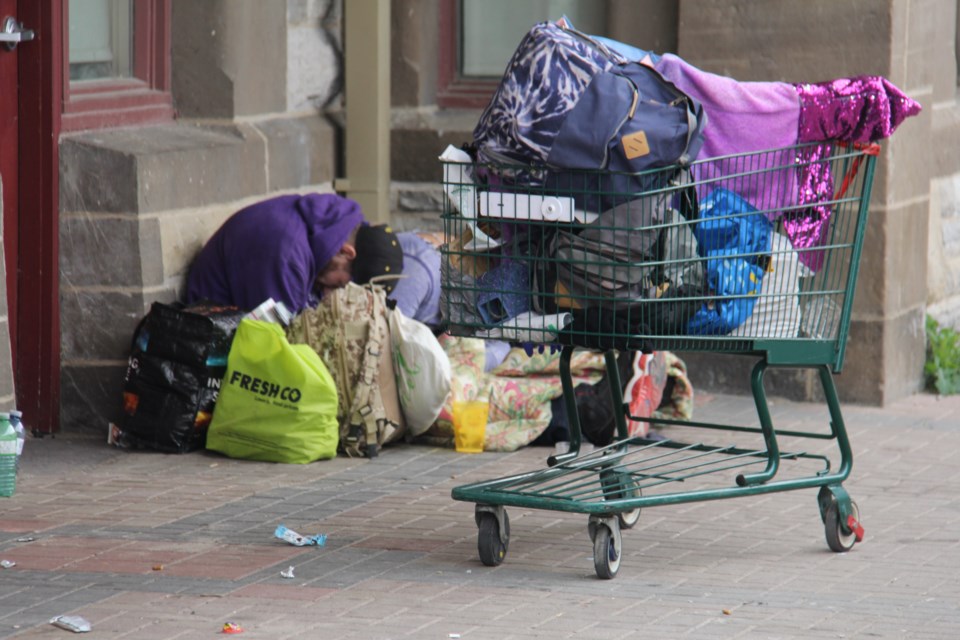The Northern Ontario Service Deliverers Association (NOSDA), in collaboration with the Association of Municipalities of Ontario (AMO) and the Ontario Municipal Social Services Association (OMSSA), has partnered with HelpSeeker to release a groundbreaking report on Ontario’s homelessness crisis, according to a news release issued Thursday.
The report, Municipalities Under Pressure: The Human and Financial Cost of Ontario’s Homelessness Crisis, quantifies the current and projected scope of homelessness, outlines the financial investments needed to achieve functional zero chronic homelessness by 2035, and identifies the funding gap across all levels of government.
“It is deeply concerning that homelessness has increased by 204 per cent in Northern Ontario and that it could increase to 26,663 people by 2035, says NOSDA Chair and Timmins Mayor Michelle Boileau. The impacts on our communities have been devastating. Municipalities cannot face this alone. We need all orders of government to step up and make real commitments to end chronic homelessness across the province. We need decisive action, now.”
The report's key findings for Northern Ontario:
- Known homelessness has surged by 204 per cent since 2016, increasing from 1,771 people to 5,377 in 2024.
- Without significant government investment, homelessness in the region could climb to between 10,674 and 26,633 people by 2035.
- The challenges in Northern Ontario are amplified by geographic isolation, limited public transportation, inadequate infrastructure, and systemic inequities, including the overrepresentation of Indigenous populations in homelessness.
“Today, we stand at a pivotal moment in Northern Ontario as we confront the heartbreaking reality of a 204 per cent increase in homelessness since 2016," states DNSSAB Chair Mark King. "This staggering rise not only highlights the urgent need for immediate action but also reveals the profound human cost of inaction
within our communities. It is essential that we secure the $11 billion investment required to achieve functional zero chronic homelessness by 2035, ensuring that everyone in our communities has a safe and stable place to call home. By investing in our communities now, we can prevent homelessness from escalating and provide critical support to those who need it most.”
While Northern Ontario has seen steeper proportional increases, other regions in Ontario are also grappling with severe growth, per the report:
- Known homelessness outside Northern Ontario has risen by 46 per cent since 2016, from 52,032 people to 76,140 in 2024.
- Projections estimate cases of homelessness outside the North could rise to between 117,448 and 267,633 people by 2035, depending on economic conditions and policy interventions.
The report models a 10-year investment scenario to achieve functional zero chronic homelessness across the province. This scenario requires:
- $11 billion over 10 years: $7.7 billion for one-time capital investments and $329 million annually for operational costs.
Additionally, the report explores solutions for addressing the pressing issue of encampments through a fixed investment scenario:
$2 billion in targeted funding: $810 million for one-time capital investments and $151 million annually for operations.
Recognizing the unique challenges of Northern Ontario, the report recommends allocating up to 20 per cent of these investments to address regional capacity gaps, infrastructure deficits, and the impact on Indigenous populations, who are disproportionately affected, representing nearly 45 per cent of
people experiencing chronic homelessness in northern communities.
- Tailored investments in culturally safe, Indigenous-led housing solutions, as well as strategies to stabilize populations locally and reduce service migration, are critical to ensuring that northern communities are equitably supported within this broader response.
In Northern Ontario, the average wait time on the Community Housing (RGI) Waitlist is 38 months.
- Northern Ontario has some of the highest percentages of housing in need of major repairs, with smaller communities experiencing even greater challenges. In many cases, over 50 per cent of housing units require major repairs and, for some communities, the figure reaches as high as 70 to 80 per cent.
Homelessness is increasing three times faster in rural communities and four times faster in northern communities.
- Transportation barriers and limited public services in Northern Ontario make accessing shelters, healthcare, and supports particularly challenging, which worsens housing instability.
While Ontario municipalities are stepping in to help, provincial and federal governments are not doing their part.
- Municipal spending on homelessness and housing programs has increased substantially in recent years, more than doubling since 2020 to over $2.1 billion in 2024, representing 51.5 per cent of the total reported funding across all three levels of government.
- Meanwhile, recent provincial and federal investments are nominal.
A fundamentally new approach is needed focusing on long-term housing solutions instead of temporary emergency measures and enforcement:
- HelpSeeker research estimates that $11 billion over 10 years could end chronic homelessness by boosting the supply of affordable housing, improving transitional and supportive services, and enhancing prevention programs.
- To largely address encampments, around $2 billion over eight years is needed.
- Recognizing the unique challenges faced by Northern Ontario, it is suggested that up to 20 per cent of the $2 billion to end encampments, be allocated to address capacity gaps, issues created by geographic isolation, and the overrepresentation of Indigenous populations in homelessness.
- In addition to representing a significant proportion of service needs, encampments in Northern Ontario are shaped by distinct local factors, including geographic isolation, higher construction costs, and limited shelter capacity. For example, northern construction costs average $500 per square foot for a standard 700-square-foot unit, resulting in $350,000 per unit. To ensure equitable funding, funding formulas must reflect these cost disparities, ensuring that resources are sufficient to address regional variations without placing undue strain on local systems.
Recent provincial investments in affordable housing and emergency shelters are appreciated but are insufficient. NOSDA says its members are ready to work with the province on a new approach that would actually solve this crisis.
